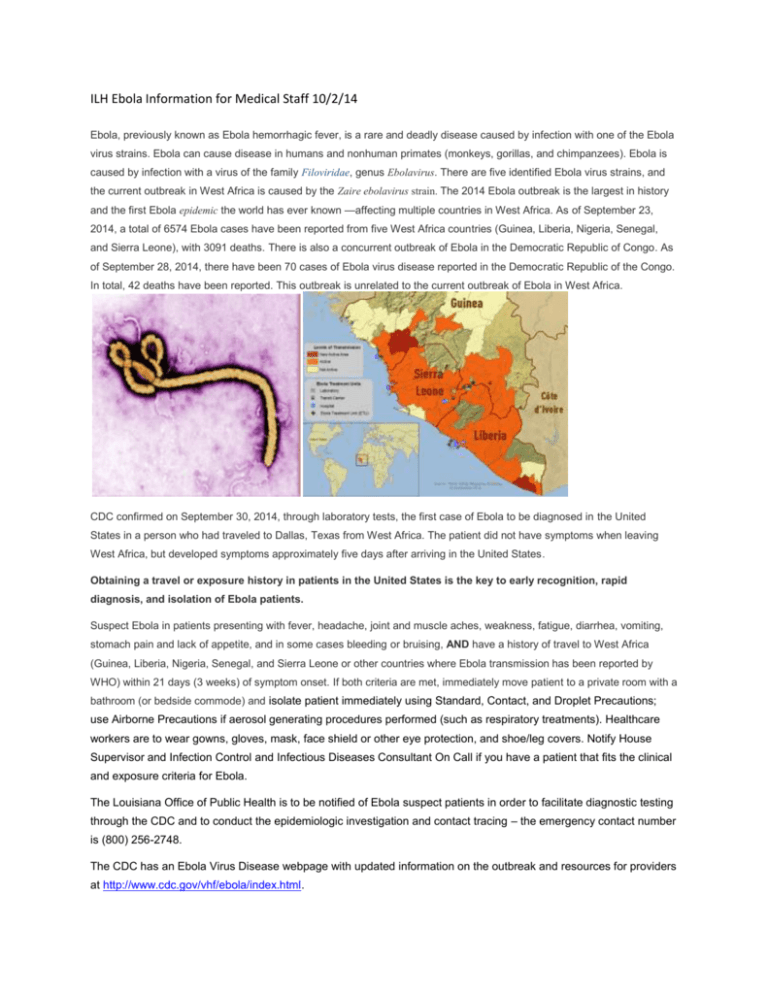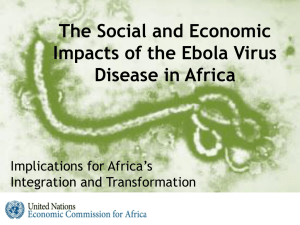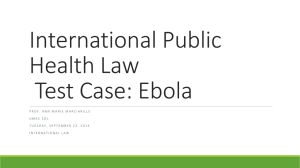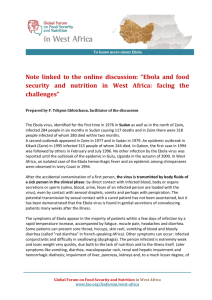ILH Ebola Information for Medical Staff 10/2/14
advertisement

ILH Ebola Information for Medical Staff 10/2/14 Ebola, previously known as Ebola hemorrhagic fever, is a rare and deadly disease caused by infection with one of the Ebola virus strains. Ebola can cause disease in humans and nonhuman primates (monkeys, gorillas, and chimpanzees). Ebola is caused by infection with a virus of the family Filoviridae, genus Ebolavirus. There are five identified Ebola virus strains, and the current outbreak in West Africa is caused by the Zaire ebolavirus strain. The 2014 Ebola outbreak is the largest in history and the first Ebola epidemic the world has ever known —affecting multiple countries in West Africa. As of September 23, 2014, a total of 6574 Ebola cases have been reported from five West Africa countries (Guinea, Liberia, Nigeria, Senegal, and Sierra Leone), with 3091 deaths. There is also a concurrent outbreak of Ebola in the Democratic Republic of Congo. As of September 28, 2014, there have been 70 cases of Ebola virus disease reported in the Democratic Republic of the Congo. In total, 42 deaths have been reported. This outbreak is unrelated to the current outbreak of Ebola in West Africa. CDC confirmed on September 30, 2014, through laboratory tests, the first case of Ebola to be diagnosed in the United States in a person who had traveled to Dallas, Texas from West Africa. The patient did not have symptoms when leaving West Africa, but developed symptoms approximately five days after arriving in the United States. Obtaining a travel or exposure history in patients in the United States is the key to early recognition, rapid diagnosis, and isolation of Ebola patients. Suspect Ebola in patients presenting with fever, headache, joint and muscle aches, weakness, fatigue, diarrhea, vomiting, stomach pain and lack of appetite, and in some cases bleeding or bruising, AND have a history of travel to West Africa (Guinea, Liberia, Nigeria, Senegal, and Sierra Leone or other countries where Ebola transmission has been reported by WHO) within 21 days (3 weeks) of symptom onset. If both criteria are met, immediately move patient to a private room with a bathroom (or bedside commode) and isolate patient immediately using Standard, Contact, and Droplet Precautions; use Airborne Precautions if aerosol generating procedures performed (such as respiratory treatments). Healthcare workers are to wear gowns, gloves, mask, face shield or other eye protection, and shoe/leg covers. Notify House Supervisor and Infection Control and Infectious Diseases Consultant On Call if you have a patient that fits the clinical and exposure criteria for Ebola. The Louisiana Office of Public Health is to be notified of Ebola suspect patients in order to facilitate diagnostic testing through the CDC and to conduct the epidemiologic investigation and contact tracing – the emergency contact number is (800) 256-2748. The CDC has an Ebola Virus Disease webpage with updated information on the outbreak and resources for providers at http://www.cdc.gov/vhf/ebola/index.html.






